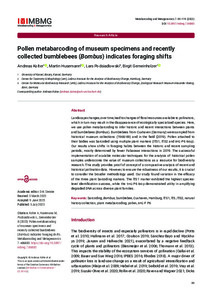| dc.date.accessioned | 2023-07-21T11:22:31Z | |
| dc.date.available | 2023-07-21T11:22:31Z | |
| dc.date.issued | 2023-07-05 | |
| dc.identifier | doi:10.17170/kobra-202307218435 | |
| dc.identifier.uri | http://hdl.handle.net/123456789/14907 | |
| dc.description.sponsorship | Gefördert durch den Publikationsfonds der Universität Kassel | |
| dc.language.iso | eng | |
| dc.rights | Namensnennung 4.0 International | * |
| dc.rights.uri | http://creativecommons.org/licenses/by/4.0/ | * |
| dc.subject | barcoding | eng |
| dc.subject | Bombus | eng |
| dc.subject | bumblebee | eng |
| dc.subject | Cuxhaven | eng |
| dc.subject | Hamburg | eng |
| dc.subject | ITS1 | eng |
| dc.subject | ITS | eng |
| dc.subject | ITS2 | eng |
| dc.subject | natural history collection | eng |
| dc.subject | plant metabarcoding | eng |
| dc.subject | pollen | eng |
| dc.subject | trnL-F P6eng | eng |
| dc.subject.ddc | 570 | |
| dc.subject.ddc | 580 | |
| dc.subject.ddc | 590 | |
| dc.title | Pollen metabarcoding of museum specimens and recently collected bumblebees (Bombus) indicates foraging shifts | eng |
| dc.type | Aufsatz | |
| dcterms.abstract | Landscape changes, over time, lead to changes of floral resources available to pollinators, which in turn may result in the disappearance of ecologically specialized species. Here, we use pollen metabarcoding to infer historic and recent interactions between plants and bumblebees (Bombus). Bumblebees from Cuxhaven (Germany) were sampled from historical museum collections (1968/69) and in the field (2019). Pollen attached to their bodies was barcoded using multiple plant markers (ITS1, ITS2 and trnL-P6 loop). Our results show shifts in foraging habits between the historic and recent sampling periods, mostly determined by fewer Fabaceae interactions in 2019. The successful implementation of scalable molecular techniques for the analysis of historical pollen samples underscores the value of museum collections as a resource for biodiversity research. This study provides proof of concept of a comparative analysis of recent and historical pollination data. However, to ensure the robustness of our results, it is crucial to consider the broader methodology used. Our study found variation in the efficacy of the three plant barcoding markers. The ITS1 marker exhibited the highest species-level identification success, while the trnL-P6 loop demonstrated utility in amplifying degraded DNA across diverse plant families. | eng |
| dcterms.accessRights | open access | |
| dcterms.creator | Kolter, Andreas | |
| dcterms.creator | Husemann, Martin | |
| dcterms.creator | Podsiadlowski, Lars | |
| dcterms.creator | Gemeinholzer, Birgit | |
| dc.relation.doi | doi:10.3897/mbmg.7.86883 | |
| dc.subject.swd | Deutschland | ger |
| dc.subject.swd | Cuxhaven | ger |
| dc.subject.swd | Hamburg | ger |
| dc.subject.swd | Pollen | ger |
| dc.subject.swd | DNA Barcoding | ger |
| dc.subject.swd | Hummel | ger |
| dc.subject.swd | Nahrungserwerb | ger |
| dc.type.version | publishedVersion | |
| dcterms.source.identifier | eissn:2534-9708 | |
| dcterms.source.journal | Metabarcoding and Metagenomics | eng |
| dcterms.source.pageinfo | 89-119 | |
| dcterms.source.volume | 7 | |
| kup.iskup | false | |
| dcterms.source.articlenumber | e86883 | |


